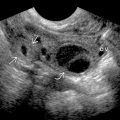IMAGING ANATOMY
Penis
- •
Composed of 3 cylindrical shafts
- ○
2 corpora cavernosa : Main erectile bodies
- –
On dorsal surface of penis
- –
Diverge at root of penis ( crura ) and are invested by ischiocavernosus muscles
- –
Chambers traversed by numerous trabeculae, creating sinusoidal spaces
- –
Multiple fenestrations between corpora, creating multiple anastomotic channels
- –
- ○
1 corpus spongiosum : Contains urethra
- –
On ventral surface, in groove created by corpora cavernosa
- –
Becomes penile bulb at root and is invested by bulbospongiosus muscle
- –
Forms glans penis distally
- –
Also erectile tissue but of far less importance
- –
- ○
- •
Tunica albuginea forms capsule around each corpora
- ○
Thinner around spongiosum than cavernosa
- ○
- •
All 3 corpora surrounded by deep fascia ( Buck fascia ) and superficial fascia ( Colles fascia )
- •
Main arterial supply from internal pudendal artery
- ○
Cavernosal artery runs within center of each corpus cavernosum
- –
Gives off helicine arteries , which fill trabecular spaces
- –
Primary source of blood for erectile tissue
- –
- ○
Paired dorsal penile arteries run between tunica albuginea of corpora cavernosa and Buck fascia
- –
Supplies glans penis and skin
- –
- ○
- •
Venous drainage of corpora cavernosa
- ○
Emissary veins in corpora pierce through tunica albuginea → circumflex veins → deep dorsal vein of penis → retropubic venous plexus
- ○
Superficial dorsal vein drains skin and glans penis
- ○
Normal Erectile Function
- •
Neurologically mediated response eliciting smooth muscle relaxation of cavernosal arteries, helicine arteries, and cavernosal sinusoids
- •
Blood flows from helicine arteries into sinusoidal spaces
- •
Sinusoids distend, eventually compressing emissary veins against rigid tunica albuginea
- ○
Venous compression prevents egress of blood from corpora, which maintains erection
- ○
Urethra: 4 Segments
- •
Prostatic urethra: Traverses prostate
- •
Membranous urethra: Short course through urogenital diaphragm (level of external urethral sphincter)
- ○
Contains bulbourethral glands (Cowper glands)
- ○
- •
Bulbous urethra: Below urogenital diaphragm to suspensory ligament of penis at penoscrotal junction
- •
Penile urethra: Pendulous portion, distal to suspensory ligament
ANATOMY IMAGING ISSUES
Imaging Recommendations
- •
Transducer: High-frequency (7.5- to 10.0-MHz) linear transducer
- •
Patient is supine with penis positioned on anterior abdominal wall
- ○
Use towels for padding, forming “nest” to keep penis in appropriate position
- ○
- •
Transducer placed on ventral side of penis
- ○
Corpus spongiosum easily compressed, so use ample gel and gentle pressure
- ○
- •
For erectile dysfunction studies, vasodilating agent is injected into dorsal 2/3 of shaft
- •
Urethra may also be examined by ultrasound
- ○
Imaging of anterior urethra is optimal with distension
- –
Gel may be injected retrograde or patient may be asked to void during scan
- –
- ○
Posterior urethra is best imaged by transrectal ultrasound of prostate
- ○
CLINICAL IMPLICATIONS
Erectile Dysfunction
- •
Complex and often multifactorial, including vascular, neurogenic, and psychologic factors
- •
Arteriogenic impotence affects inflow
- ○
Usually internal pudendal and penile arteries
- ○
Blockage may be as high as distal aorta (Leriche syndrome)
- ○
Cavernosal artery evaluation
- –
In flaccid state, there is little diastolic flow
- –
At onset of erection, there is dilatation with increase in both systolic and diastolic flow
- –
At maximum erection, venous drainage is blocked
- □
Waveform changes to high resistance with reversal of diastolic flow
- □
Peak systolic velocity > 30 cm/s
- □
Cavernosal artery diameter increase > 75%
- □
- –
- ○
- •
Venogenic impotence affects outflow
- ○
Ineffective venoocclusion with continuous outflow of blood from sinusoids
- ○
At peak erection end, diastolic flow is reversed or absent
- –
End diastolic velocity > 5 cm/s indicative of venous insufficiency
- –
- ○
Penile Trauma
- •
Penile fractures occur by forceful bending of erect penis, typically during intercourse
- ○
Results in rupture of corpus cavernosum with tearing of tunica albuginea
- ○
Patients often report “snap” followed by immediate pain
- ○
Expanding hematoma; if Buck fascia also disrupted, may extend to perineum and scrotum
- ○
- •
Need to carefully evaluate tunica albuginea for any areas of disruption
- •
Document location and extent of hematoma
Peyronie Disease
- •
Localized, benign, connective tissue disorder with fibrotic plaque formation on tunica albuginea
- ○
Causes painful erections with shortening and curvature of penis
- ○
- •
Scan tunica albuginea carefully looking for areas of hyperechoic thickening ± calcifications
PENIS AND URETHRA










